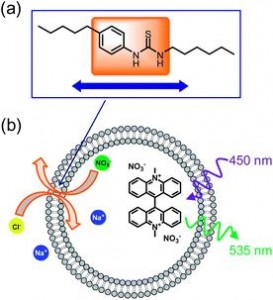An international team of scientists have made a material capable of both piezoelectric and ferromagnetic behaviour. The discovery opens up the possibility of a new class of polarisable and magnetic compounds, and could lead to better devices for storing electronic information.
New data storage techniques are in demand to meet the ever-increasing use of digital information. Present methods rely on the writing and reading of computer bits by electricity, and require a high electrical current. This generates heat so the amount of data that can be stored on a drive is limited by how efficiently the device can be cooled.

The alternating layers of YFeO3 and LaFeO3 give the structure its unusual polarisation properties
One possible solution is to read the bits electronically but write them magnetically, thereby removing the need for high electrical currents and cooling mechanisms. This method requires a material in which the electrical polarisation can be controlled by changing the magnetic field, but so far no such materials have been discovered.
A crucial first step is to find materials that can display both electrical polarisation and magnetisation at the same time, known as multiferroic materials. Multiferroic materials are challenging to make as there is often competition between their electronic structure requirements, which give rise to each property, and they also have strict symmetry conditions for the overall crystal structure of the material, which must be fulfilled.
Electrical polarisation is impossible in materials with a centre of inversion, so breaking the inversion symmetry of the material is crucial for electrical polarisation to occur. As this is a very common property of many materials’ crystal structures, this limits the number of potential compounds capable of showing multiferroic behaviour, and remains a barrier to the possibility of magnetic data writing.
However, the new approach described by Matthew Rosseinsky, from the University of Liverpool in the UK, and colleagues, side-steps this problem by showing how two centrosymmetric perovskite materials can be combined in such a way as to break the inversion symmetry of the whole material. Depositing alternating layers of yttrium iron oxide (YFeO3) and lanthanum iron oxide (LaFeO3) using a laser produces a larger heterostructure in which the alternating layers of Y3+ and La3+ cations combine with the tilting of the FeO6 octahedra to remove the centre of inversion symmetry.
Read the full article in Chemistry World»
Read the original journal article in Chemical Science – it’s free to download until 25th March:
Engineered spatial inversion symmetry breaking in an oxide heterostructure built from isosymmetric room-temperature magnetically ordered components
J. Alaria, P. Borisov, M. S. Dyer, T. D. Manning, S. Lepadatu, M. G. Cain, E. D. Mishina, N. E. Sherstyuk, N. A. Ilyin, J. Hadermann, D. Lederman, J. B. Claridge and M. J. Rosseinsky
Chem. Sci., 2014, Advance Article, DOI: 10.1039/C3SC53248H, Edge Article



















